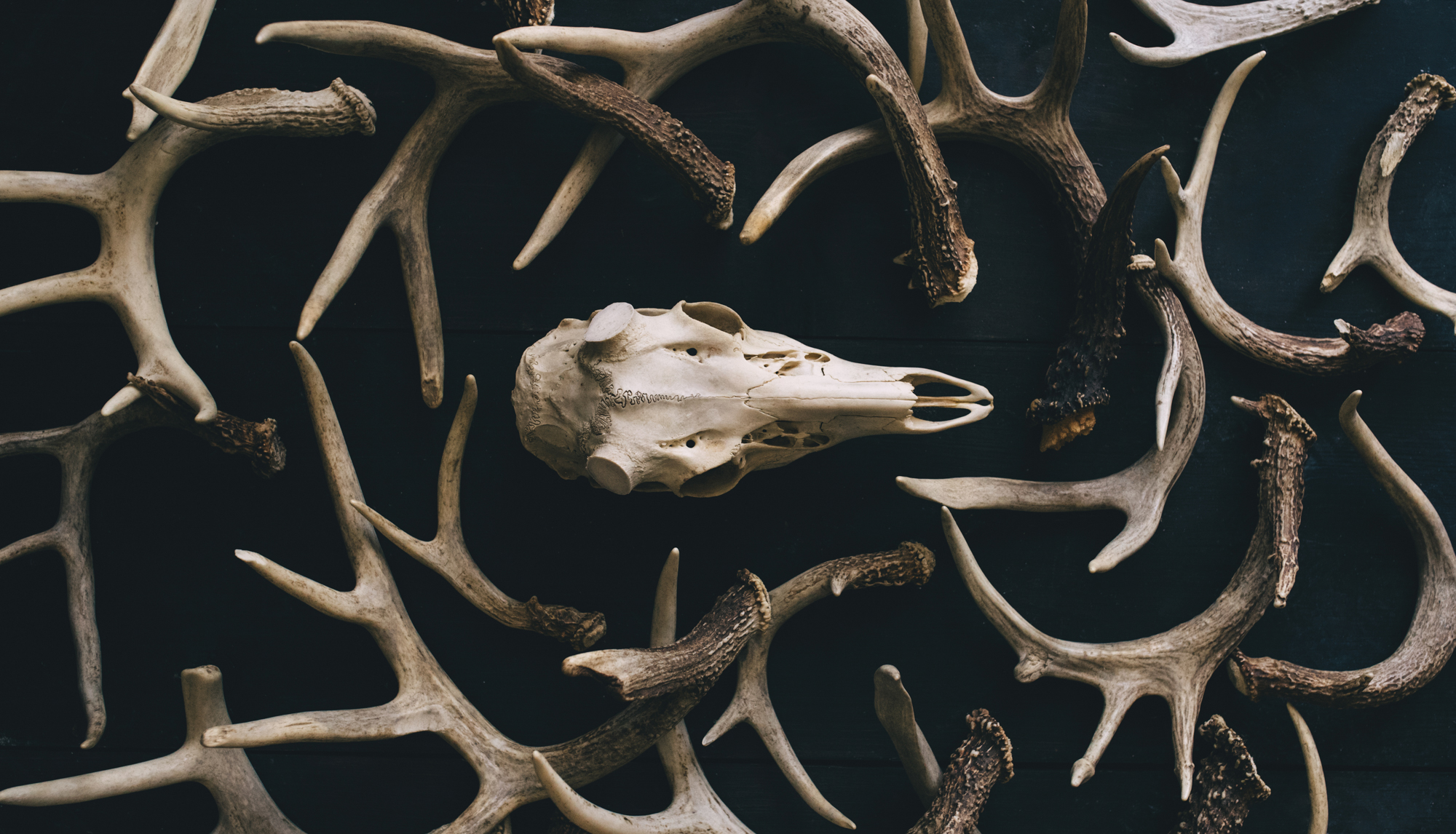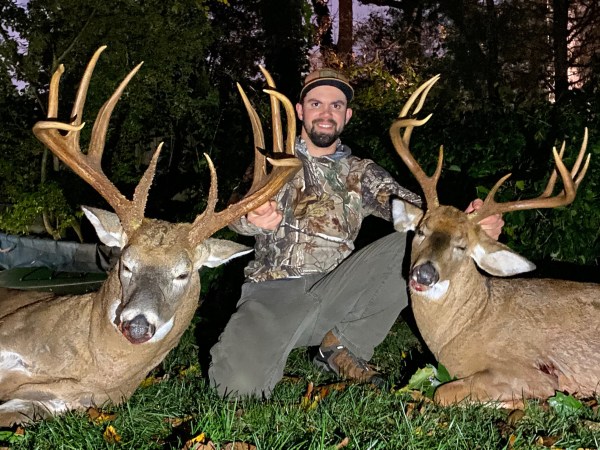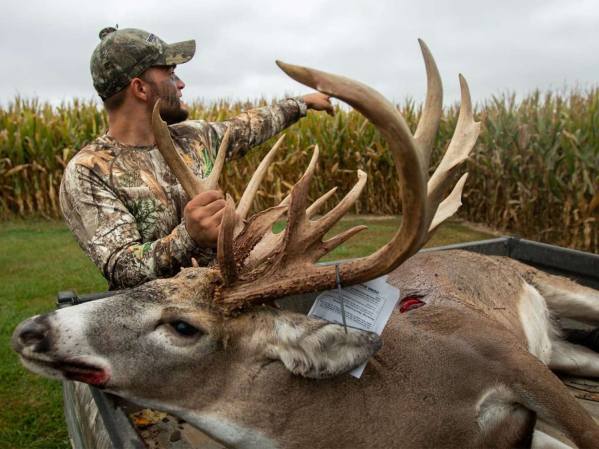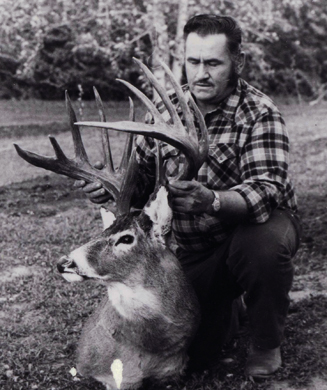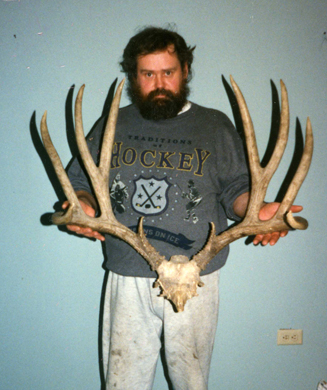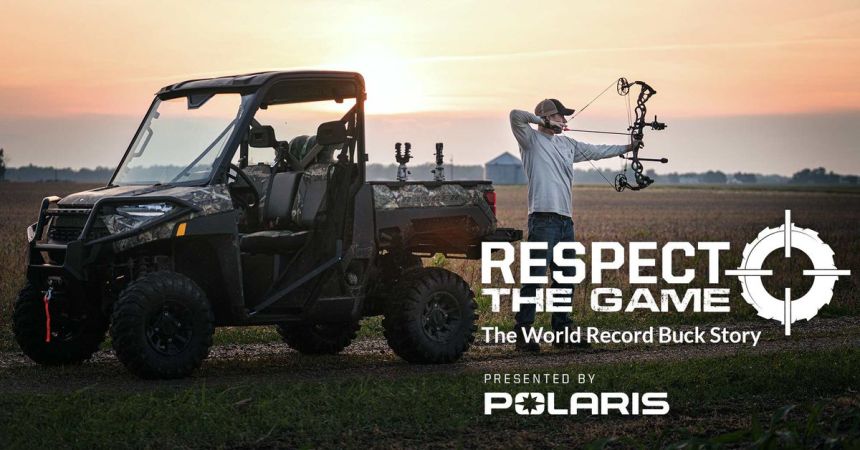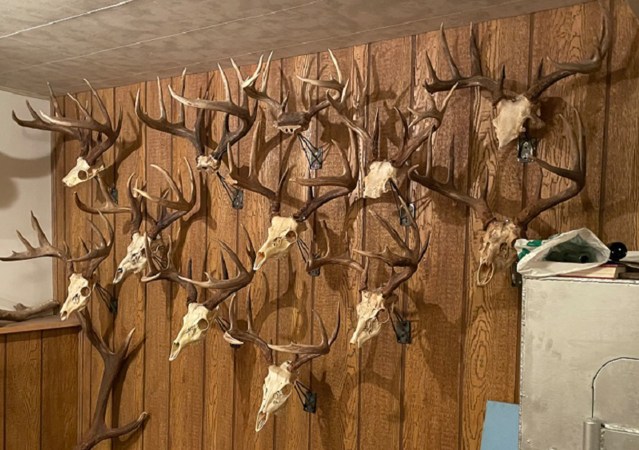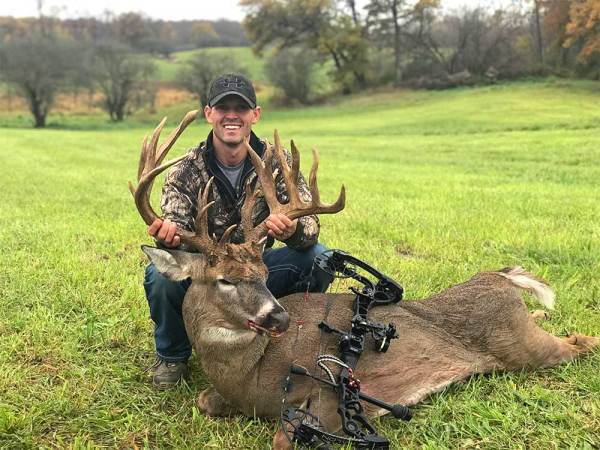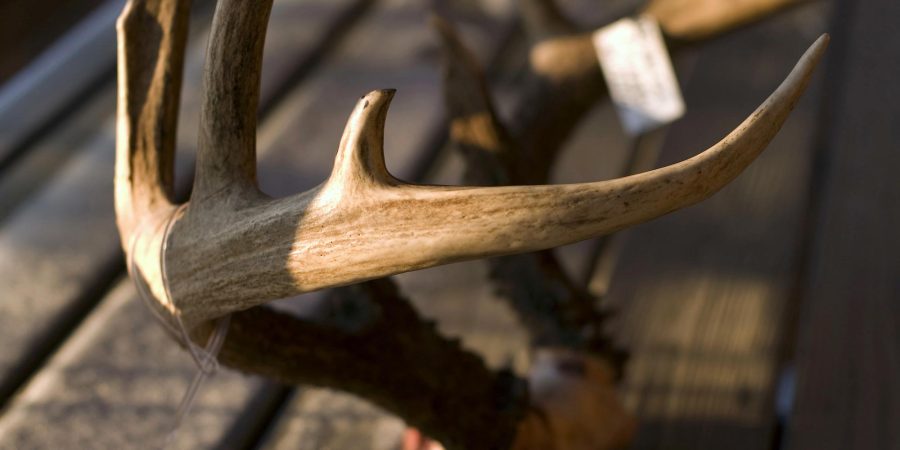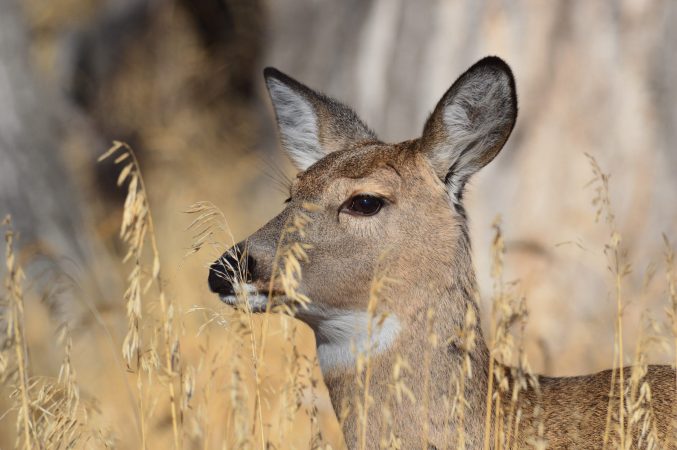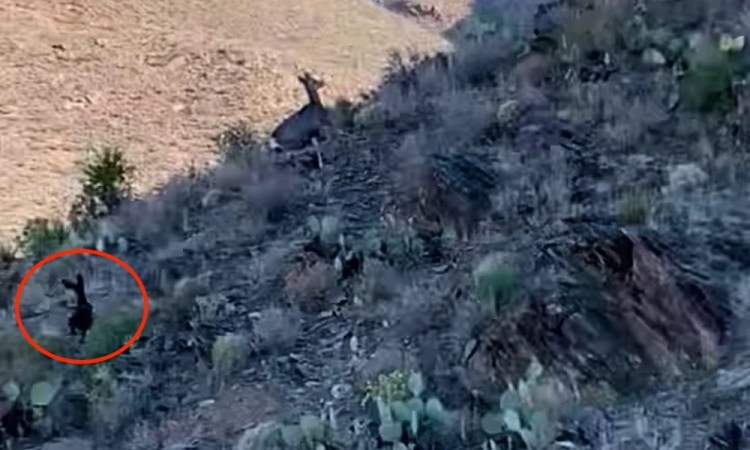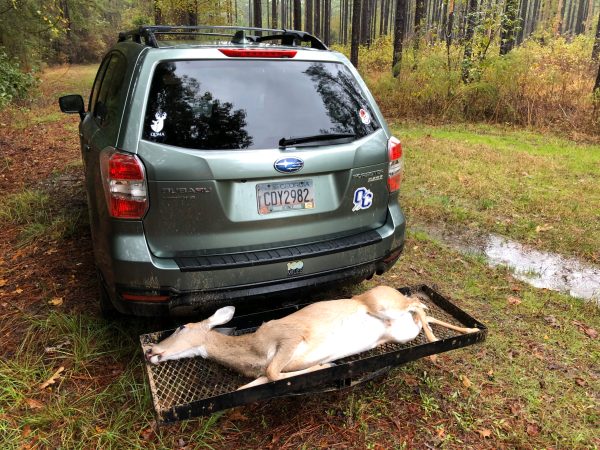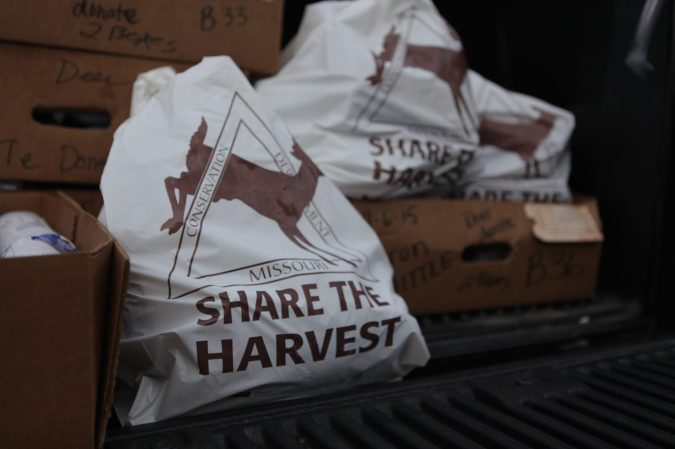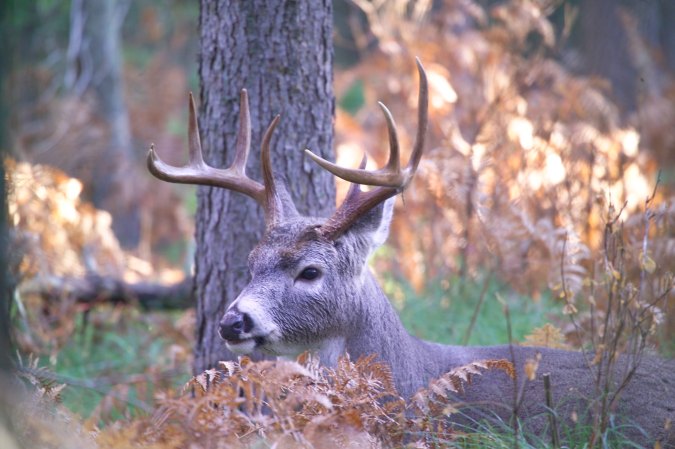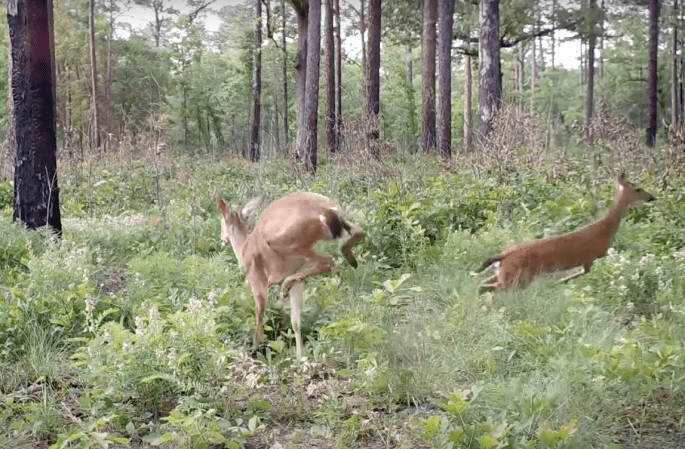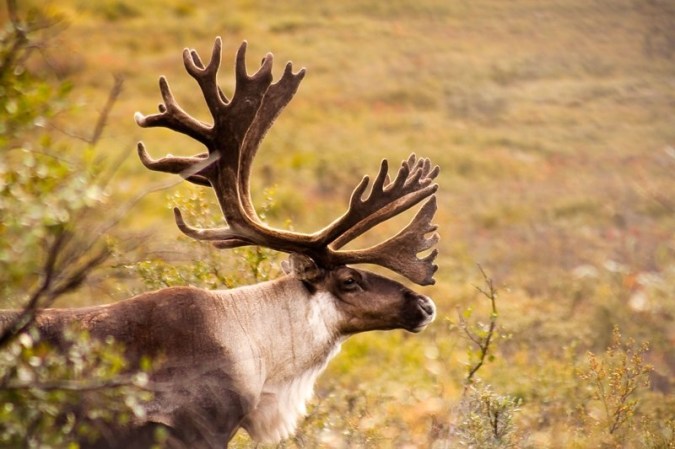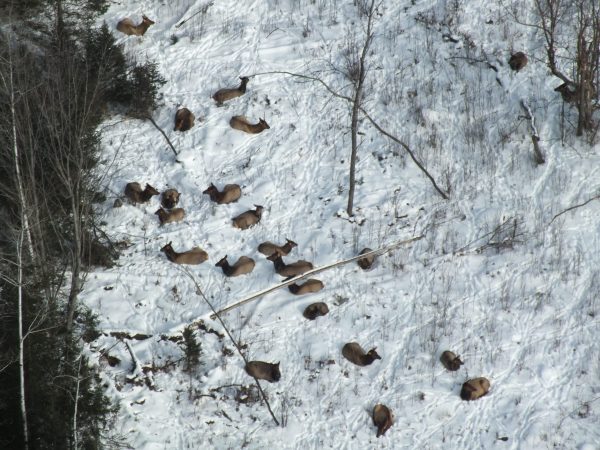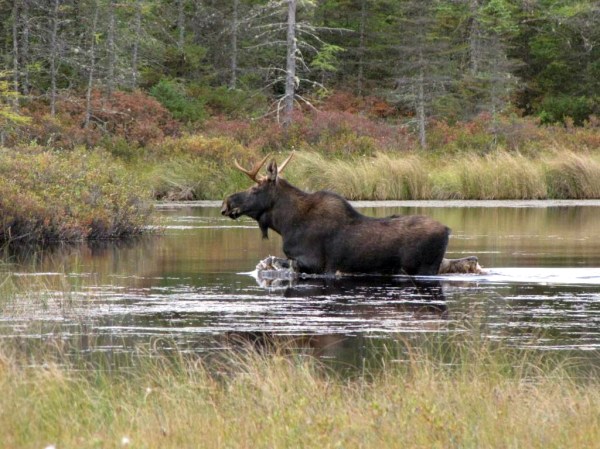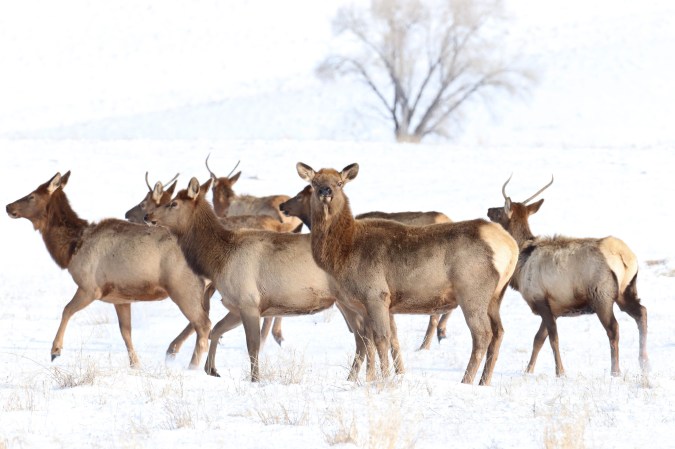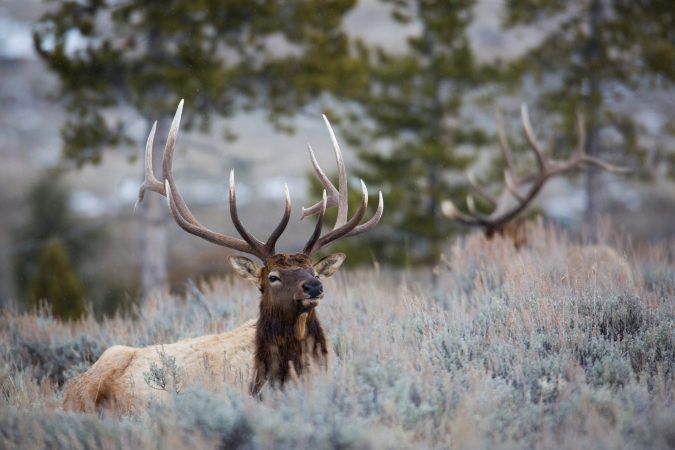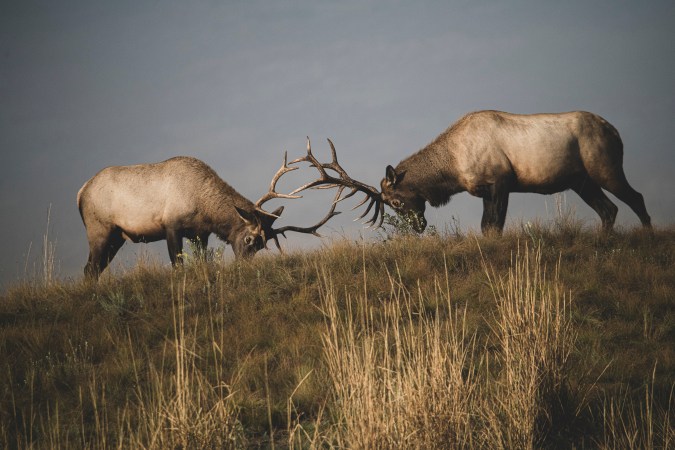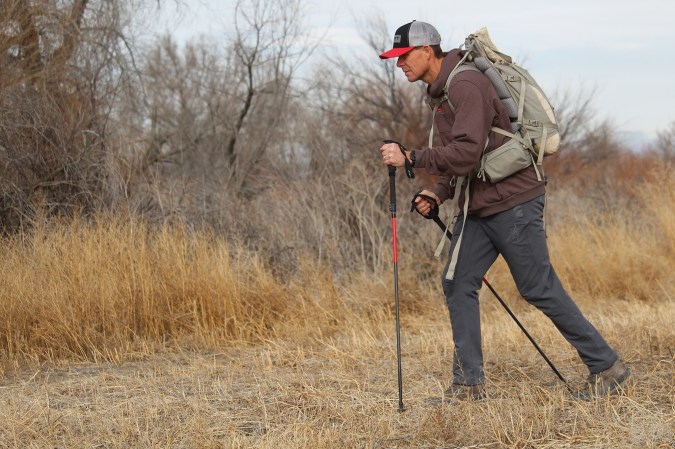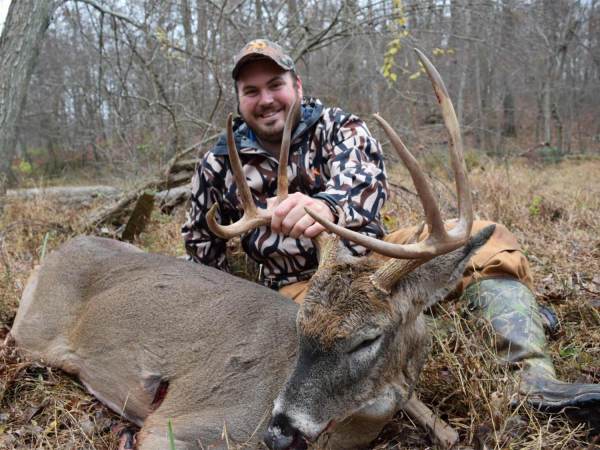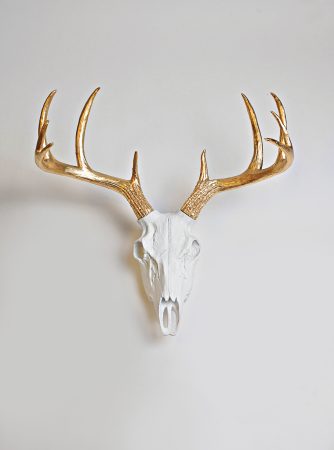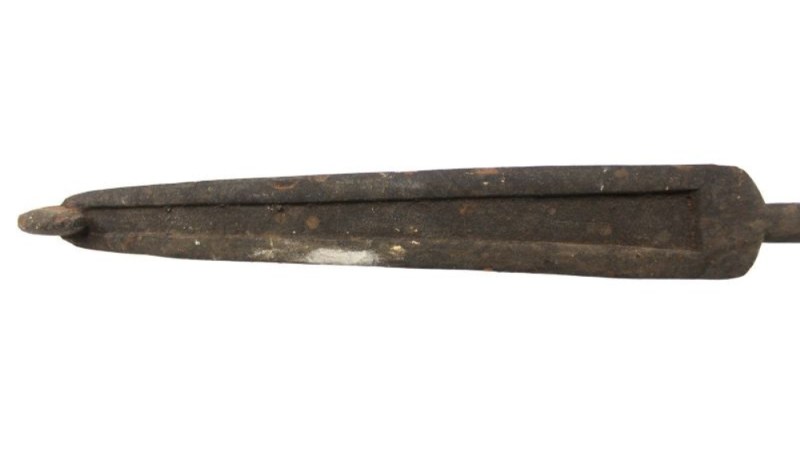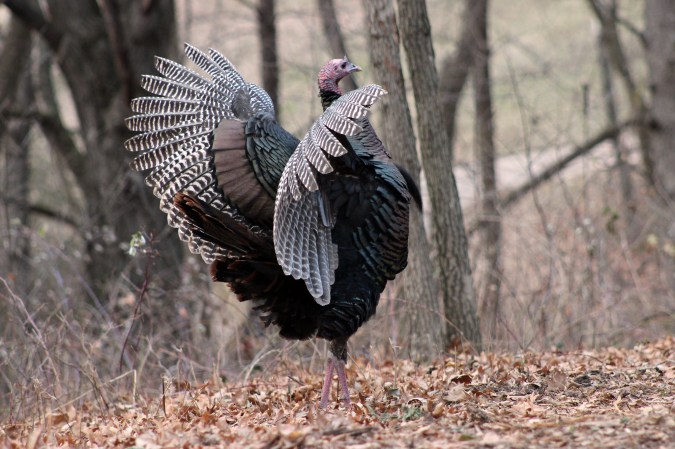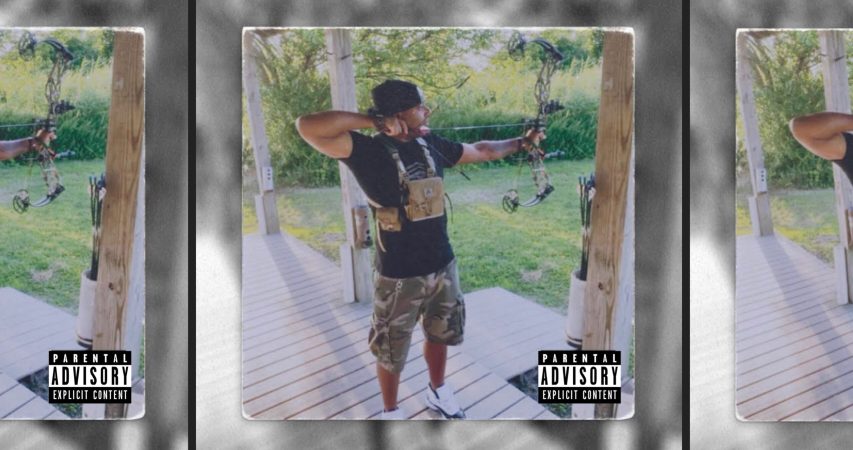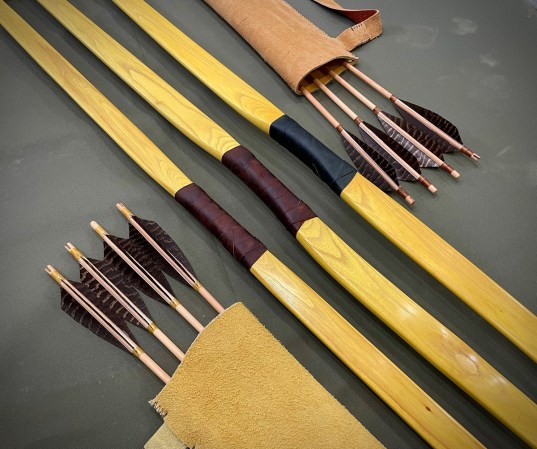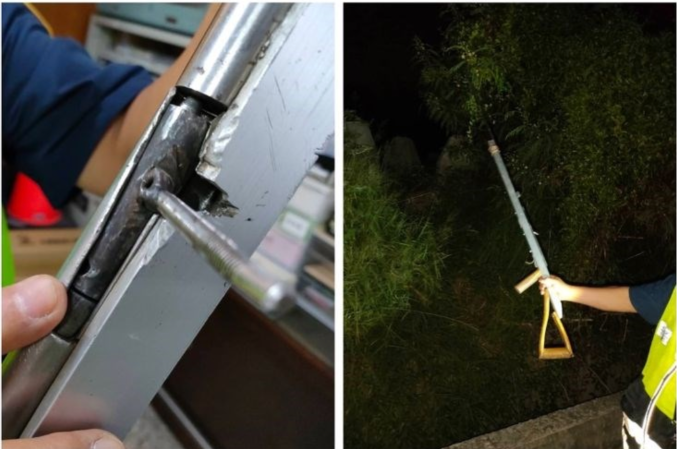JIMMY LYNN WOKE UP grinning in his tent on Sept. 23. He was eight miles deep in Wyoming’s Hoback range, and he’d killed a big 6×6 mule deer the day before. Now he had two days to wait for his ride out on horseback, and he was in no rush to leave camp. After a slow breakfast, he hiked back up to where he’d stashed the buck’s quarters. He carried that meat to a tree closer to camp, where he’d hung the backstrap, tenderloins, and head the night before.
When Lynn reached the tree, he found it was empty. His first thought was that a grizzly bear had raided his cache, but when he noticed boot prints and saw that his knots had been untied, he went straight from puzzled to pissed. After all the work it had taken to notch a coveted tag on a 180-class mule deer, someone had stolen the skull.
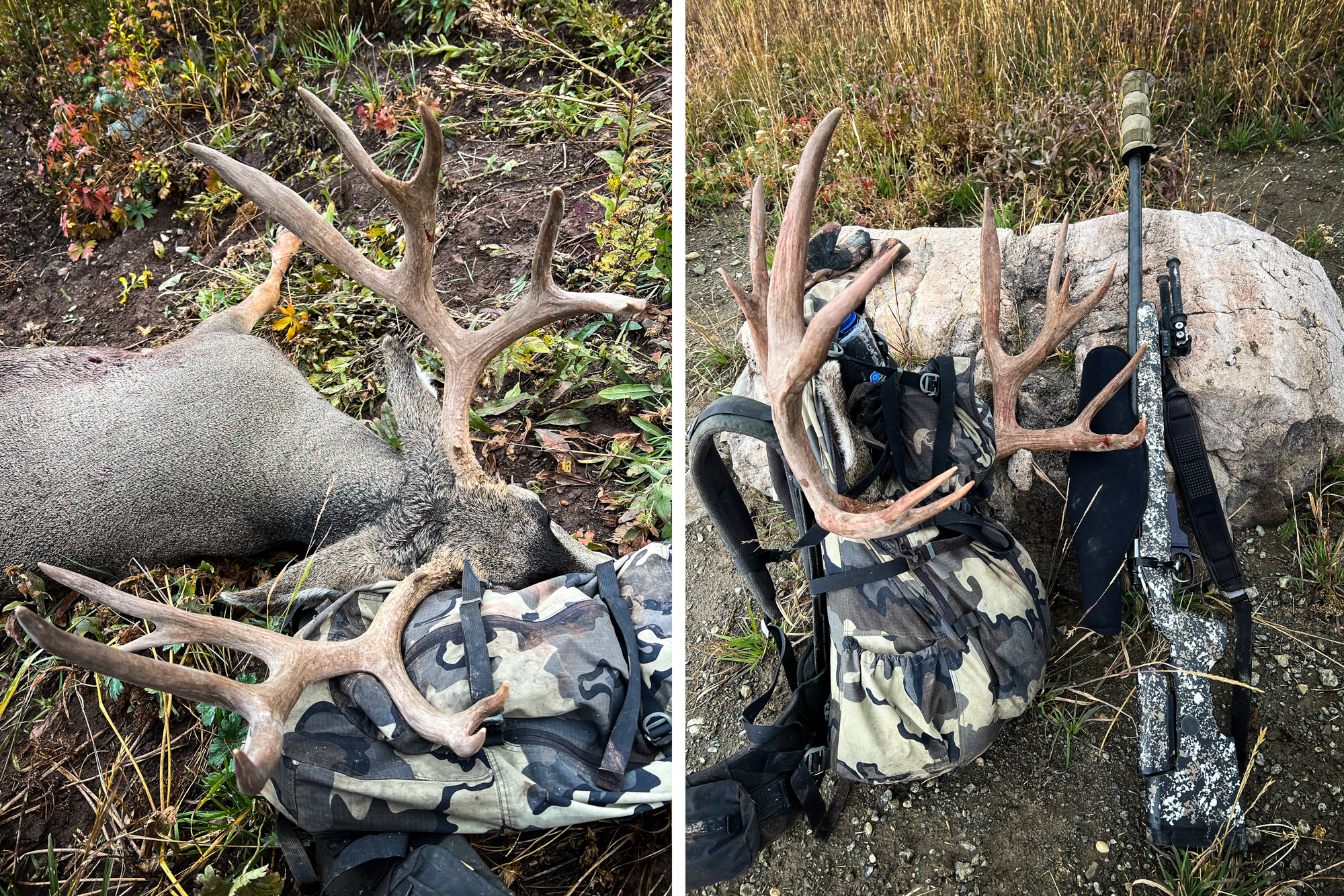
“That tag took me nine years to draw and cost me $660, not to mention all the gas, time, scouting, and everything else that you pay and do to go on a hunt like that,” says Lynn, who works as a taxidermist in Utah. “And then you get kicked in the balls.”
He’s not alone in his misfortune, and over the next four weeks, two more antler thieves would strike as freshly tagged trophies were stolen from cities in Montana and Wyoming. Other thefts have taken place in other states, but in the intermountain West especially, it seems like more and more racks are getting jacked these days. Local law enforcement, antler buyers, and taxidermists all agree that it’s a growing problem—as do the hunters who’ve had their hard-earned trophies vanish.
As for what’s causing the uptick in antler thefts, there seem to be two major factors: a booming antler market, and a weak set of laws surrounding stolen animal bones. Taken together, these provide more than enough motivation for criminals to turn a buck.
From Motel Parking Lots to Backyard Boiling Pots
Early in the morning of Oct. 8, Tom Schneider stared at his truck in the parking lot of the C’Mon Inn in Billings. He dreaded the phone call he was about to make but didn’t have much of a choice.

He’d pulled into the motel late the night before with a truck bed full of precious cargo. This included the head and cape of a 340-inch bull elk, and a KUIU drybag loaded with thousands of dollars’ worth of hunting gear. It all belonged to his brother-in-law, and after securing the head and gear bag with ratchet straps, he thought everything would be safe enough while he caught a few hours of sleep. But now the truck bed was empty.
Adam Grenda had another tag to fill, so he was still in elk camp when he picked up the phone. A bush pilot who lives in southwest Alaska, Grenda hunts plenty and he’s had a hell of a year already. Before his elk hunt in Montana, he killed his biggest moose to date in Alaska and tagged a book ram in Idaho. Still, he was heartbroken when he heard the news.
“That elk was probably my most special trophy yet because I killed it with a [bow],” says Grenda. “It’s just so cool that you can kill an animal that big with a sharp stick. I’m not a huge bowhunter, so to have it all come together, and for my brother-in-law to see and film the whole thing, it was really special.”
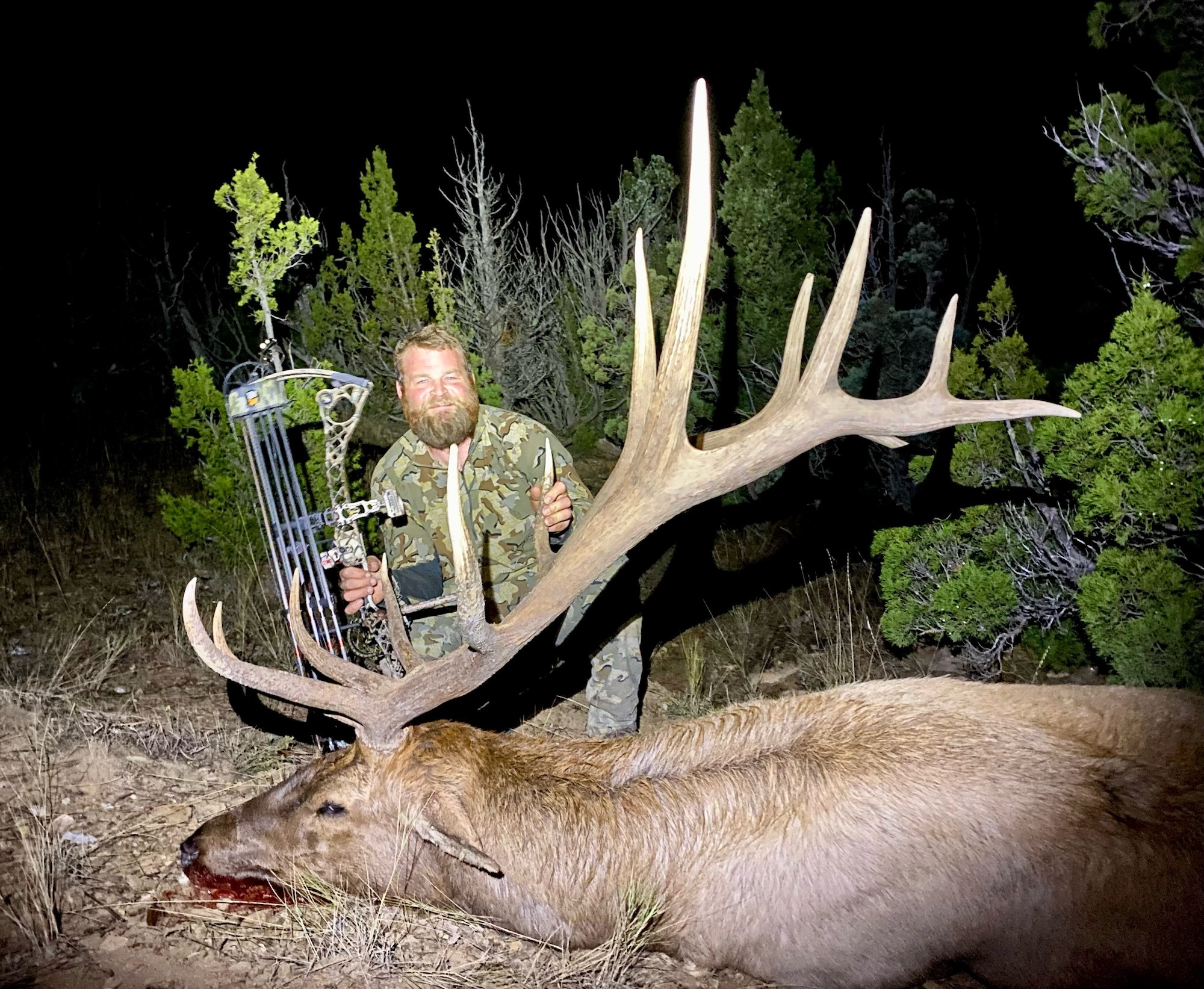
After filing a police report that afternoon, neither Grenda nor Schneider thought they’d ever see the elk again. Still, Grenda figured his best chance was to broadcast the theft over social media and he shared photos of the bull to Instagram on Oct. 8. His post spread like wildfire throughout the hunting community.
Grenda was just getting home to King Salmon the following day when he received a message from a police officer in Billings letting him know his antlers had been recovered. The officer explained that an antler buyer in Laurel, Montana, had seen Grenda’s post. After comparing the photo of the missing elk with some antlers he’d bought off a woman days before for $350, the buyer decided to call the police.
“Apparently this woman, who had sold antlers to him in the past, brought them into his shop with the head and cape still attached,” Grenda says. “He didn’t think about it at first, but after they cut the antlers off and threw the rest in the garbage, he thought, this is suspicious. Then he saw my post on Facebook and figured he didn’t want any part of it, so he called it in, and the cops showed up. They eventually sent me a picture of the antlers, and they’re now in the evidence room.”
He says that even though the loss of his hunting gear still stings, he’s relieved (and just as surprised) that his antlers turned up. But while the bull’s recovery made for a mostly happy ending for Grenda, most antler theft victims aren’t so lucky. One week to the day after Grenda’s bull was stolen in Billings, the skull of another trophy bull was taken from a boiling pot in a backyard in Wyoming. That skull is still missing, and local law enforcement confirms their department has closed the investigation.
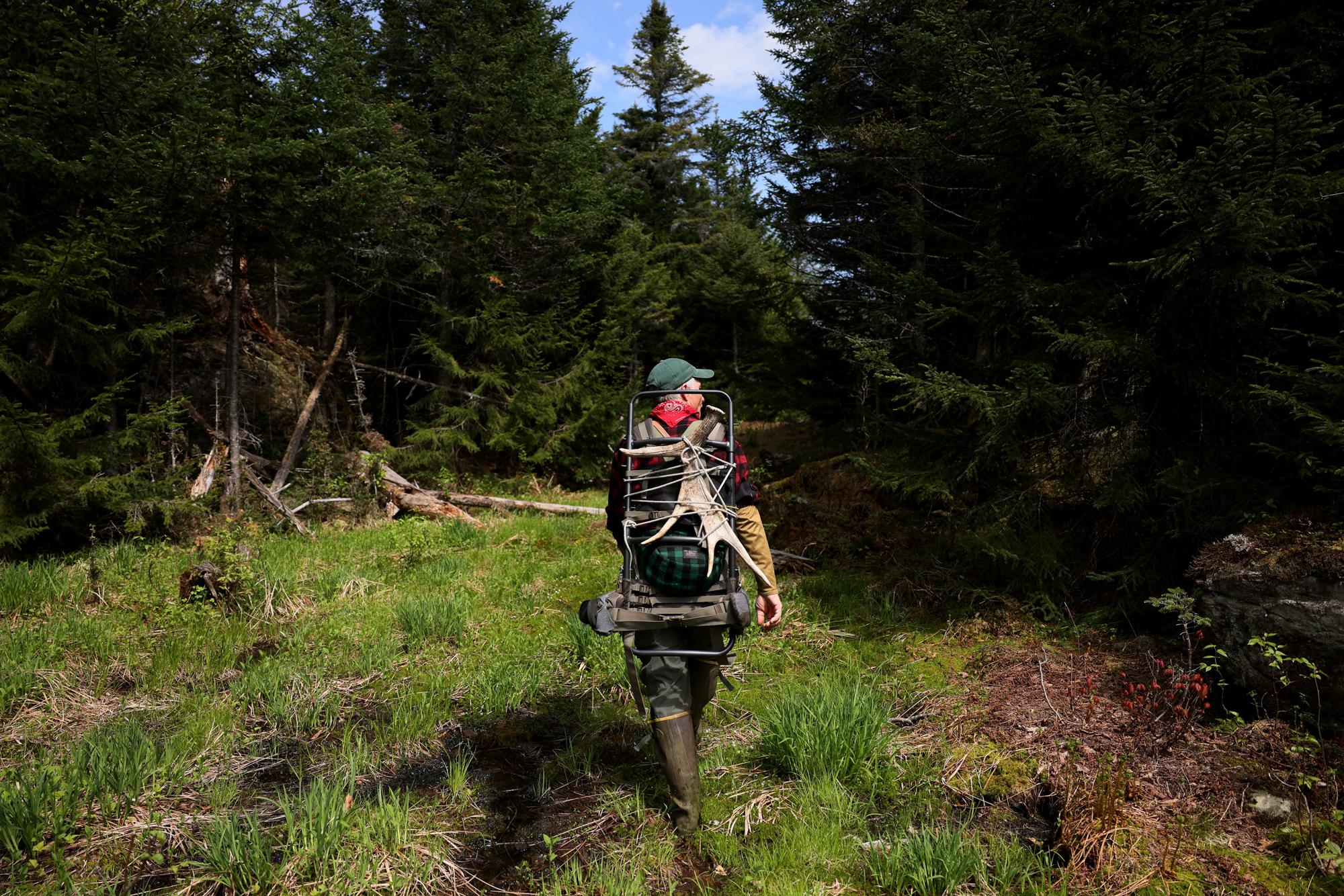
The hunter doesn’t expect to recover his antlers, but he asked to remain anonymous in case the investigation re-opens. He suspects that a well-intentioned (and now deleted) social-media campaign to recover the skull likely backfired.
“The moment they saw those photos pop, they probably got the bandsaw out,” the hunter says. “The simple fact is you have to burn the body. The smartest thing they could do is cut it up into dog bones, which I’m sure they did by now.”
The Law Hasn’t Caught Up to Antler Thieves
The case of the backyard bull remains a mystery. But even though the antlers themselves were exceptional, local investigators in the region say the storyline is one they’re all too familiar with nowadays.
“It used to not be a thing, but it seems like it’s becoming more prevalent these days,” says Ron Wells, a sergeant at a small-town police department in central Wyoming. “We’ve seen a couple [cases] every year over the past few years, and that’s just in our department, not the whole county. I think most of this stuff is driven by money, and I think it’s one of those markets where it’s easy to get rid of. Antlers are easy to hide, cut up, or dispose of.”
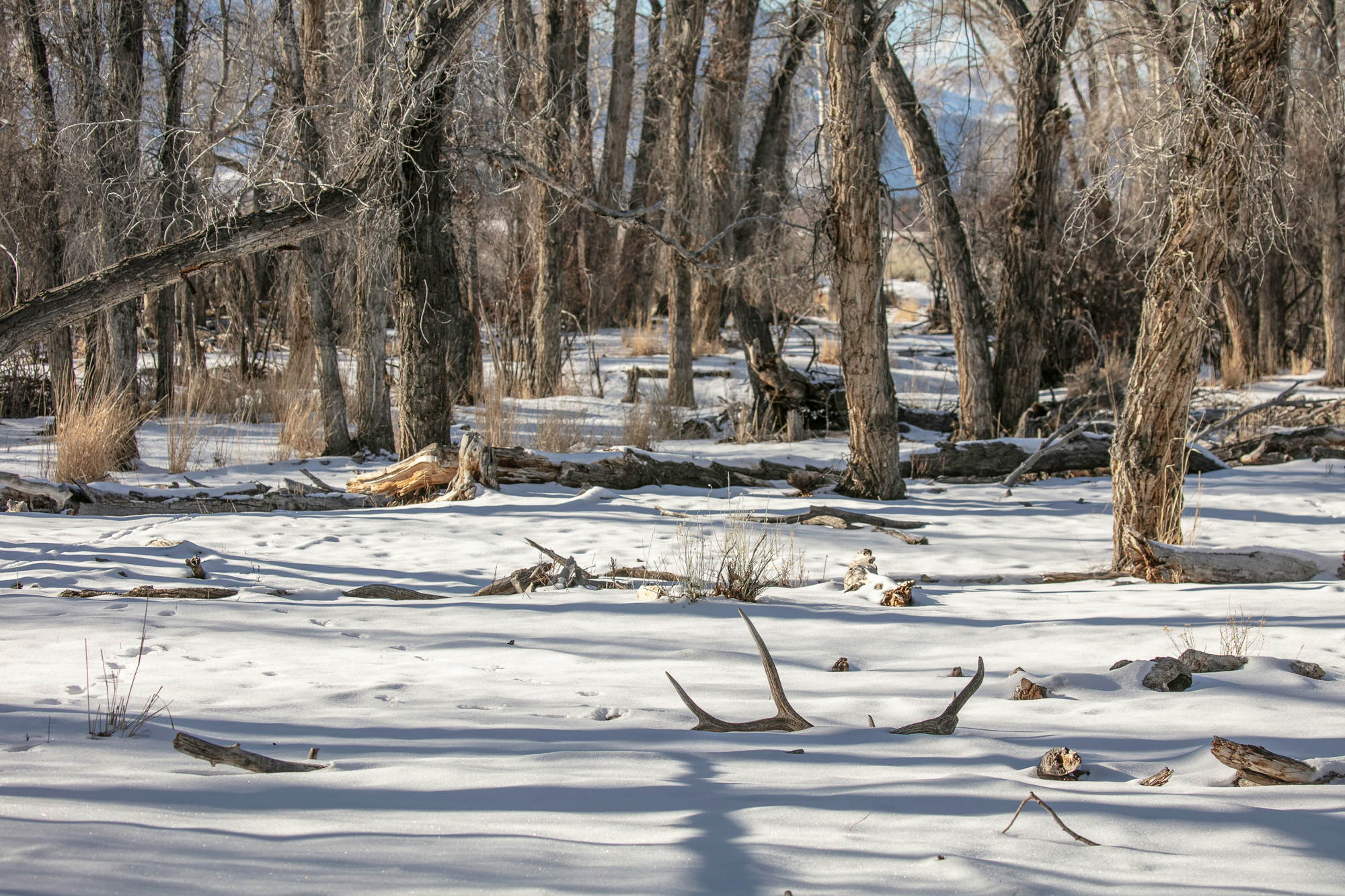
Wells tells Outdoor Life that he’s already investigated multiple cases of antler theft in his local precinct this fall. (Wyoming’s general deer season hadn’t even opened when we spoke in October.) He says none of those cases have been solved and that most of the time, the trails go cold pretty quickly. The only exceptions are when they get a tip, or when the thieves also steal something that is easier to trace, and the antlers are found along with it.
Another reason these cases are so hard to crack is because antler theft is not considered a violation of the Lacey Act, Wells says, so the feds never get involved. State fish and game agencies don’t concern themselves with stolen antlers either, according to Rene Schell, a spokesperson with the Wyoming Game and Fish Department. She explains that these incidents are handled entirely by local law enforcement because as soon as a hunter puts a tag on an animal, it’s no longer considered a resource of the state.
“Once an animal gets tagged it’s someone’s personal property, so it’s a property crime,” Schell says.
This fact might surprise some hunters. It certainly surprised Lynn, who called a WGFD wildlife officer as soon as he realized his Hoback buck had disappeared.
“I was already texting the [game warden] when it finally occurred to me that it was a person that did it,” Lynn says, “and he told me there was literally nothing he could do about it.”
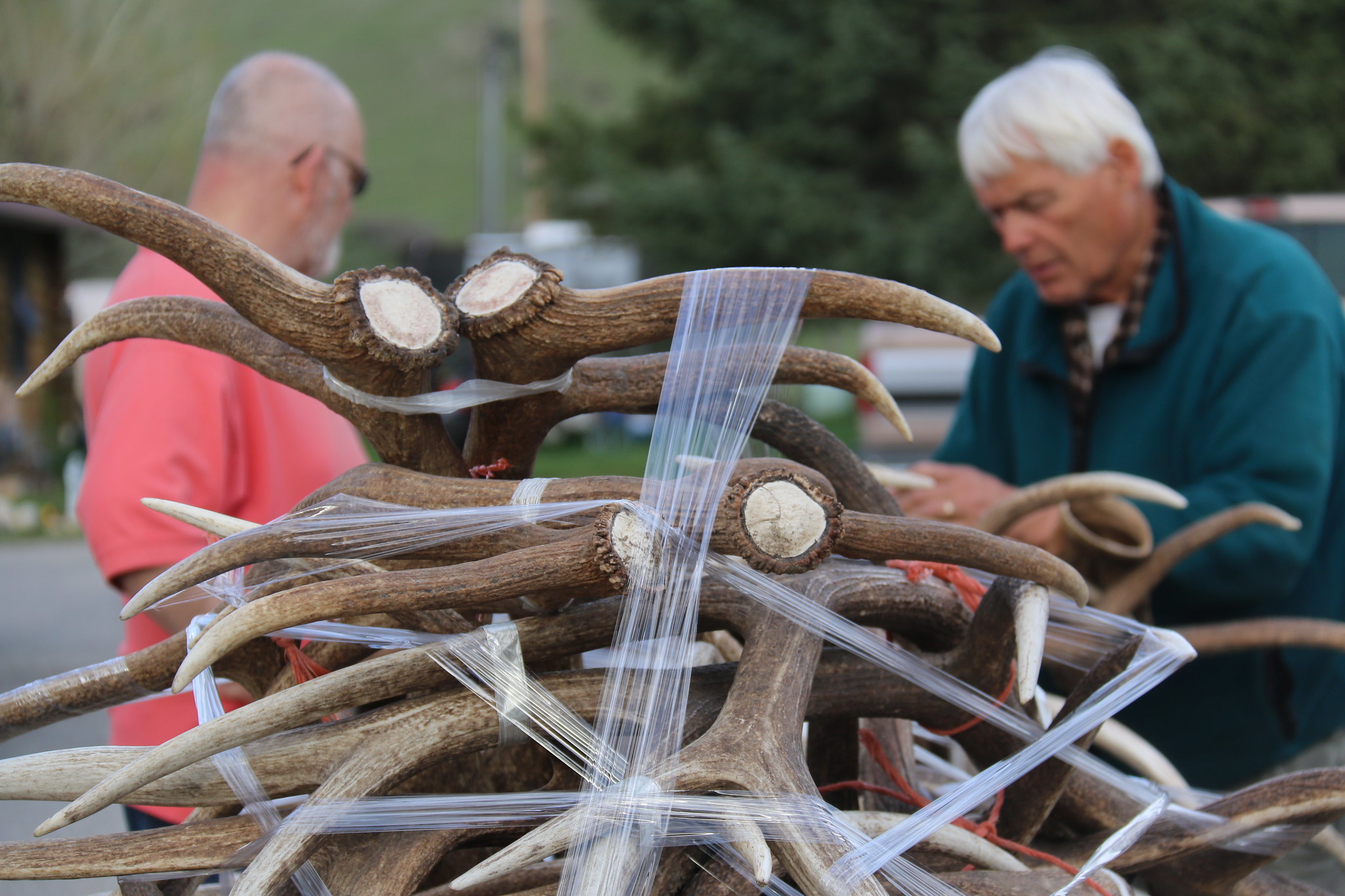
Hunters in other parts of the country have experienced similar nightmares, but overall, antler theft seems to be more prevalent in the West. This could be due to the number of hunters who travel there and can’t easily secure their antlers. Or perhaps it’s because backcountry big-game species like mule deer and elk are typically quartered for pack out, and unattached skulls are easier to steal. (Both Lynn and Grenda were from out of state.)
The heads of trophy whitetails in the East, by comparison, are more compact, and they usually stay attached to the carcass until they’re either brought home or taken to a processor or taxidermist. And, while antler buyers exist all over the country, there are a lot more of them in Colorado than there are in Iowa. Simply put, antlers are big business in the West.
The Growing Antler Market in the West
Cory McIlveen owns Bone Head Antler Brokers in Grand Junction, Colorado. He started out as a local buyer 10 years ago, and now he travels throughout the region, buying and selling up to 120,000 pounds of antlers every year.
“Some of my buddies who shed hunted, they made like $2,500 one year, and it blew my mind that you can make that much money selling horns,” McIlveen says. “Then I met some people who were paying more than what the local people were, and I got the idea that I’ll just buy all my buddies’ antlers and take the whole pile to [those guys]. It took me awhile to be able to buy a bunch, but I probably did about 10,000 pounds that first big year. The year after that I really blew up. I think I did like 50 or 60,000 pounds.”
Mark Sanders, a local antler buyer based in Fremont County, Wyoming, explains that antler prices are set according to three main categories or “grades.” With the exception of the really big trophy skulls, all antlers are bought and sold by the pound.
“The way I grade them, you have brown, hard white, chalk, or D grade,” Sanders says. “A brown antler doesn’t have to be dark brown—it’s just an antler with no cracks in it. That’s your A grade. B-grade antlers would be considered hard white, and they’re still hard with some cracks. And C grade is chalk. It starts to get more of a sandpaper texture and maybe a grayish color.”
D-grade antlers are the lowest quality. These are the bleached and brittle sheds that end up at the bottom of the barrel after years in the elements.
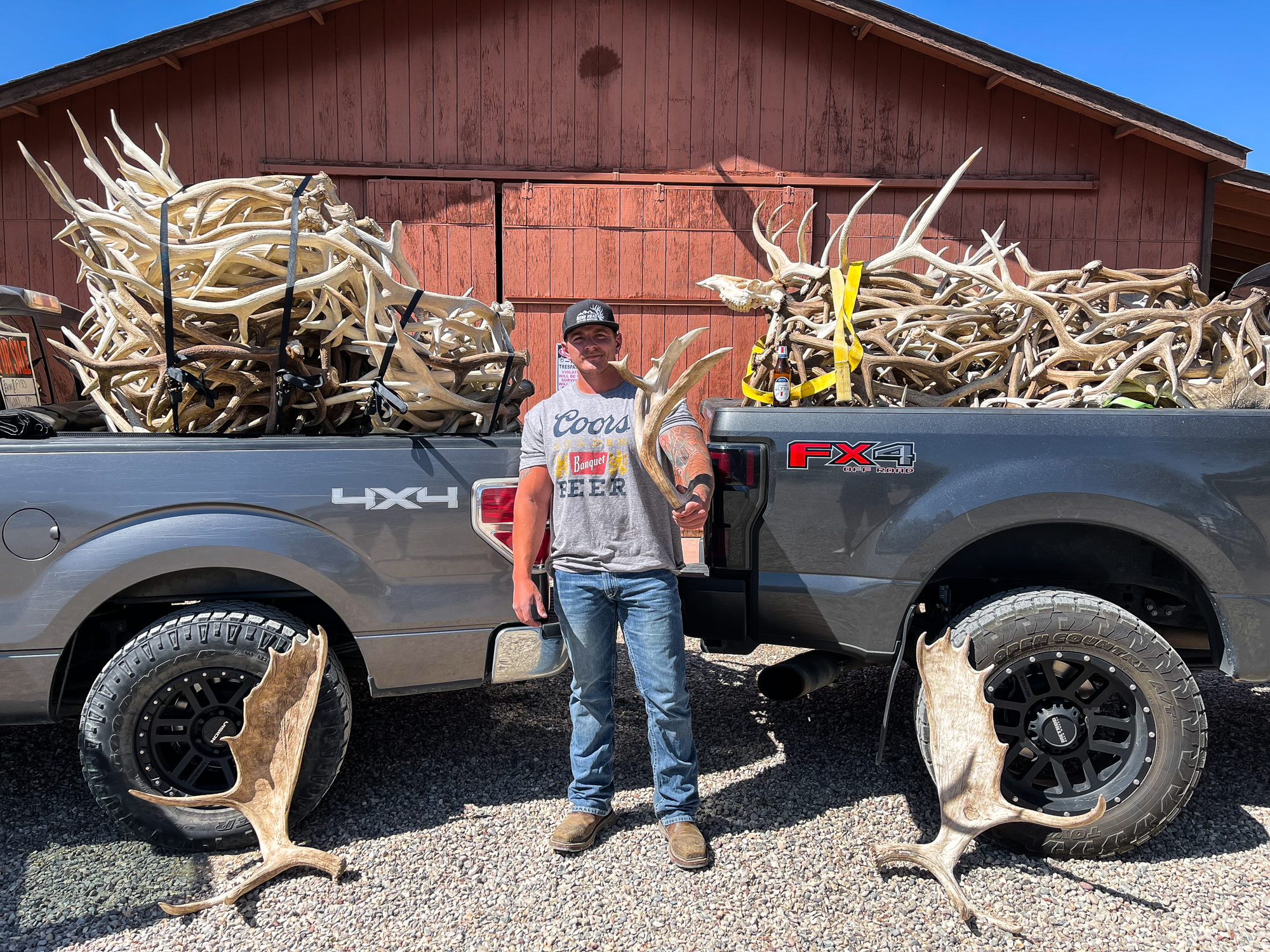
Like any marketable good, the price of antlers fluctuates every year. But according to McIlveen, prices have been climbing steadily since he got in the game. When he first started in the early 2010’s, brown elk antlers were selling for $12 to $13 per pound. Now the average price per pound is closer to $18 to $20.
“The prices have gone up slowly every year,” McIlveen says. “[In 2021] it was around $16, and everyone thought that was crazy—they said it wouldn’t go any higher. And then [in 2022] it went up another two to four dollars. I think it’s peaked, but it’s going to stay fairly high because the dog chews are such a big market.”
He explains that around 90 percent of the antler dog chews that are sold in pet stores are wild antlers. Antlers from high-fenced deer and elk won’t do, he says, because a lot of ranchers cut the animals’ horns off early to keep them from killing or wounding each other.
“If they’re not fully hard-horned, they’re still growing,” he says of those antlers. “And there’s a lot of blood in those horns. When dogs chew on them their saliva gets them wet, and they start bleeding again, which gets all over and smells really bad. The antlers from pen-raised [animals] don’t have very good color either. I mean the dog doesn’t care, but the dark-colored antlers are always the most expensive because people like seeing chocolate antlers more than the white ones.”
McIlveen says he doesn’t bother with making dog chews, since the cutting process generates a lot of waste and requires more work than you’d think. His favorite part of the job is moving the high-end, trophy-caliber bone. Whether it’s a matching set or a skull with the antlers still attached, these primo racks transcend the per-pound realm of the market and can fetch tens of thousands of dollars. According to McIlveen, a big set of elk antlers might top out around $1,500. A quick glance at Etsy, however, shows that online shoppers are willing to pay nearly twice that amount.

“And for a big mule deer rack,” he adds, “there’s almost no ceiling. I know people who have bought heads for $30,000 to $40,000, and the biggest set I sold was for $25,000. It’s just insane. There are a few big collectors I know and all they do is collect mule deer horns.”
McIlveen says the reason mule deer horns are worth up to ten times as much as whitetail and elk horns is because muleys don’t do as well on high-fence ranches.
“You can get crazy whitetail antlers from all the high-fence places, and there’re so many of those that people can just go buy a set for 700 to 800 bucks,” he says. “But you can’t really grow mule deer, so if you get a really big set of muley sheds, you know they’re wild.”
There are essentially three tiers of horn buyers fueling the antler market in the West. There’s the small-timer who operates at a local level, buying from friends and other known contacts and maybe picking up a few sheds on the side. These buyers will either use antlers to make craft goods like knives, lamps, and chandeliers, or they’ll sell their piles to people like McIlveen, who make up the middle tier and operate regionally. These mid-level buyers travel from state to state buying truckloads of antlers from locals and then re-selling them to the small handful of major buyers in the country.
In this way, nearly all the antlers that are bought and sold throughout the West end up in the possession of a handful of big-time buyers. These high-level brokers will move 200 thousand pounds of bone or more each year, and most have contracts with pet-store chains to meet the insatiable demand for “wild, organic” dog chews.
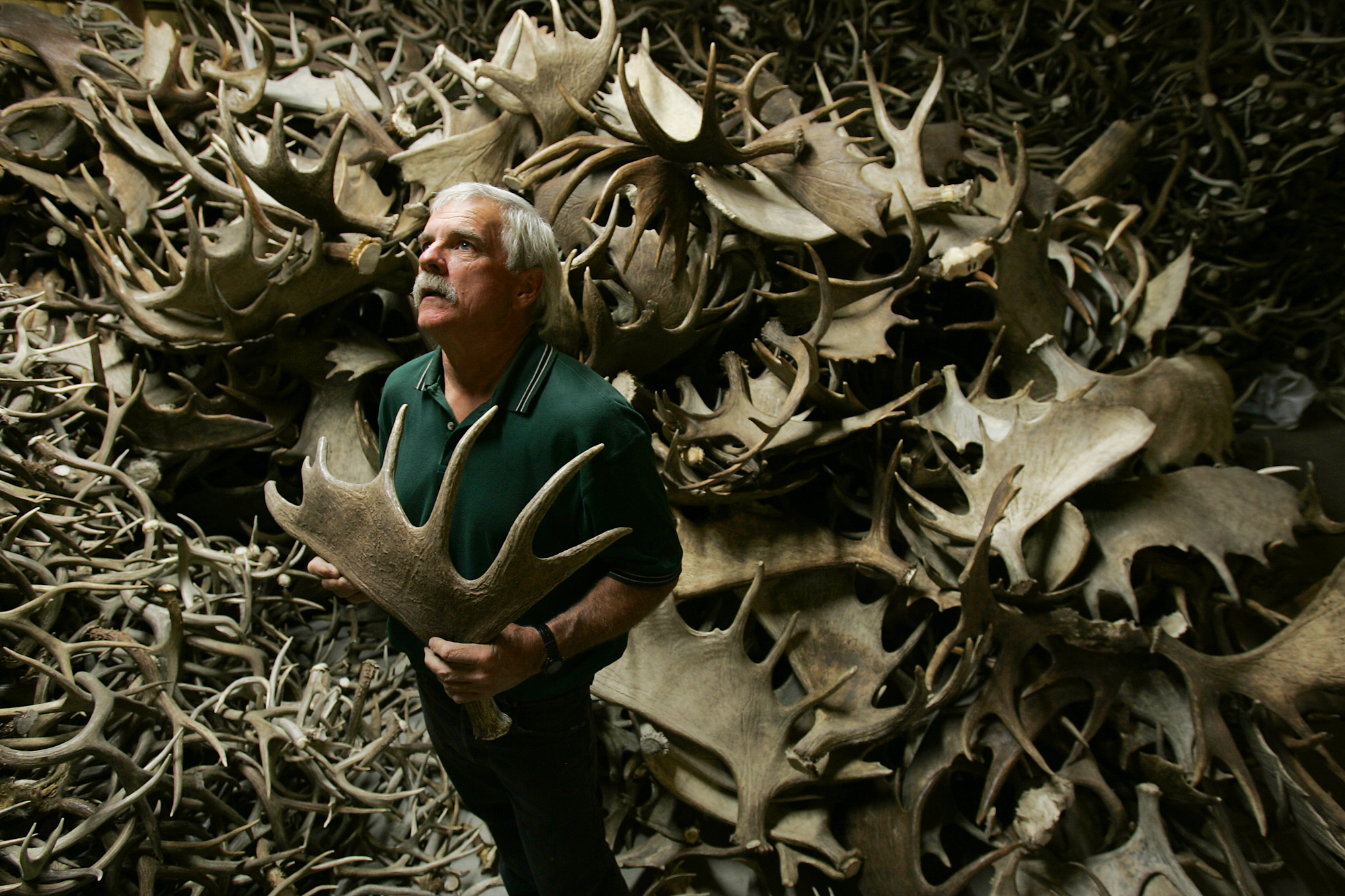
“It’s exactly like the fur market,” says Don Schaufler, one of the biggest antler brokers in the country and the owner of Antler Designs in Ennis, Montana. (You might remember Schaufler as the broker who purchased the Broder buck, the world-record nontypical mule deer, more than two decades ago.) “You have the local trappers or hunters who get the fur, and they sell them to somebody else. Then the furs change hands three or four times, but most of them end up in the same place.”
Schaufler says there wasn’t really any money in antlers until around 40 to 50 years ago, when demand from Asia created a market overseas. He explains that the current demand for dog chews has raised the prices so much that importers there have cut back in recent years. But there will always be some buyers in China and other Asian countries, where hard-horn antlers and velvet are used in health foods and traditional herbal medicines.
“Deer antler base has been recorded in the Chinese medical [books] for 2,000 years, and is believed to nourish the Yin, tonify the kidney, invigorate the spleen, strengthen bones and muscles, and promote blood flow,” according to the National Library of Medicine. “In China, deer antler base has been extensively used in traditional Chinese medicine to treat a variety of diseases including mammary hyperplasia, mastitis, uterine fibroids, malignant sores and children’s mumps.”
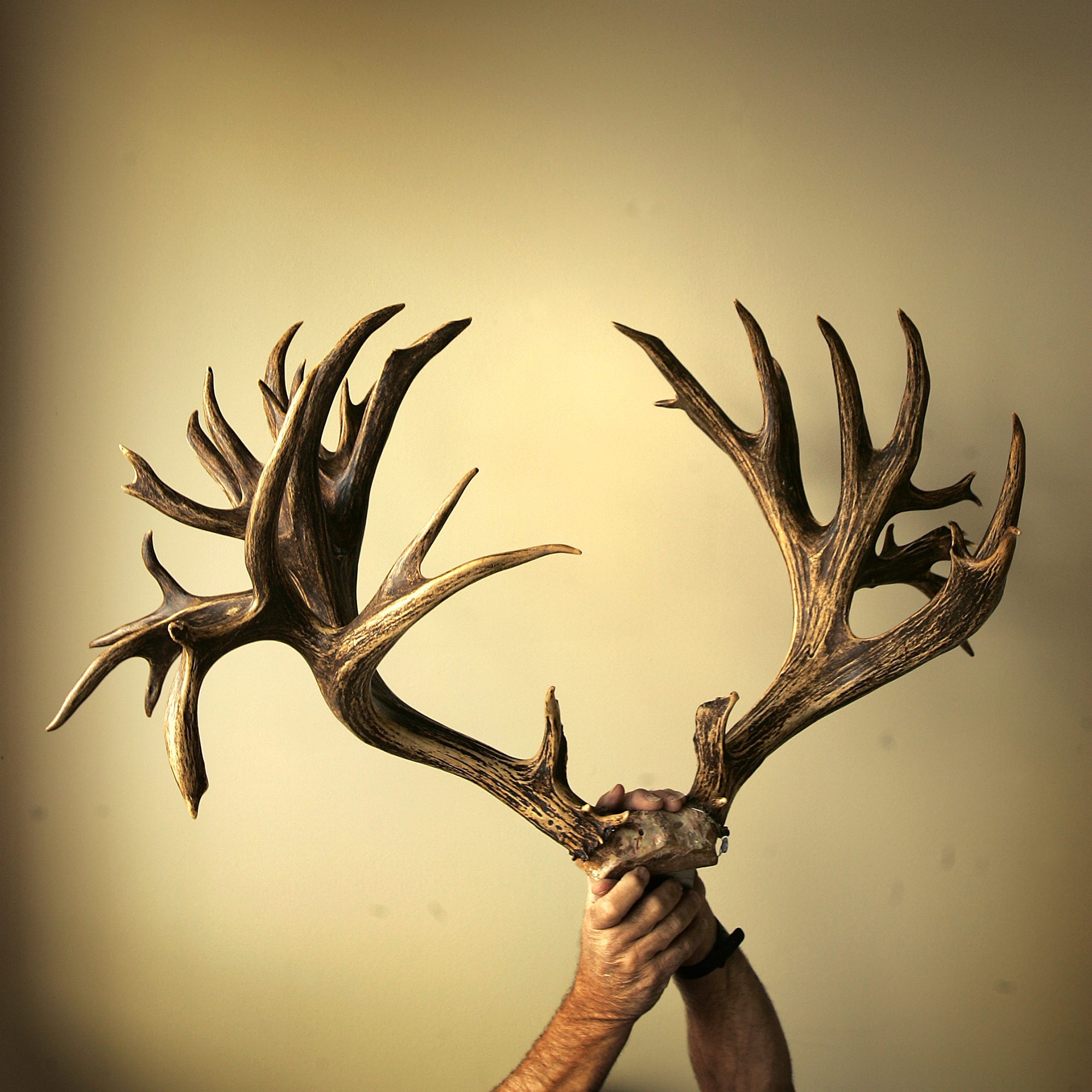
Even though there is little to no scientific evidence supporting such claims, deer antler supplements have also gained a small foothold here in the United States, where they are marketed specifically to athletes and bodybuilders. Pure Velvet Extracts, for example, sells a single ounce of liquid antler extract for $149.99. It’s one of several companies that claims its products will increase strength and endurance by boosting the production of a natural growth hormone known as Insulin-like Growth Factor 1 (IGF-1).
A pair of clinical studies from 2003 and 2005 mostly debunked these claims. But today, a quick online search for “deer antler supplements” will bring up dozens of sprays, liquids, and capsules, proving that a niche market still exists for these items.
To Catch an Antler Thief
The fact that buyers like Schaufler, McIlveen, and Sanders are honest businessmen doesn’t change the reality that there’s an underground element to the antler-selling market. Many brokers, especially the local ones, operate by word-of-mouth only, and most transactions are done in cash. This allows criminals to offload stolen horns quickly and easily by contacting a local buyer.
Which is exactly what happened in the case of Bobby and Franny Esplin, taxidermists who had three finished euro mounts (two bull elk and one mule deer buck) stolen from their yard on Aug. 28. Franny explains that Esplin’s Wildlife Studio is located on the same property as their home, which lies off a dead-end road outside of Delta, Colorado. She says people rarely drive by, and that they’re still wondering how the suspect knew about the skulls in the first place.
“He came up the road and parked near our neighbor’s driveway,” she says. “He had to go through this sagebrush flat, and he was able to avoid our cameras at first, but they caught just a flash of him when he was walking out carrying the antlers. So now [we] have a lot more cameras.”
That blurry photograph wasn’t enough evidence for the police to go on, so Esplin did the same thing that Grenda did when he lost his bull. She posted photos of the three mounts to Facebook in the hopes that someone would recognize them.
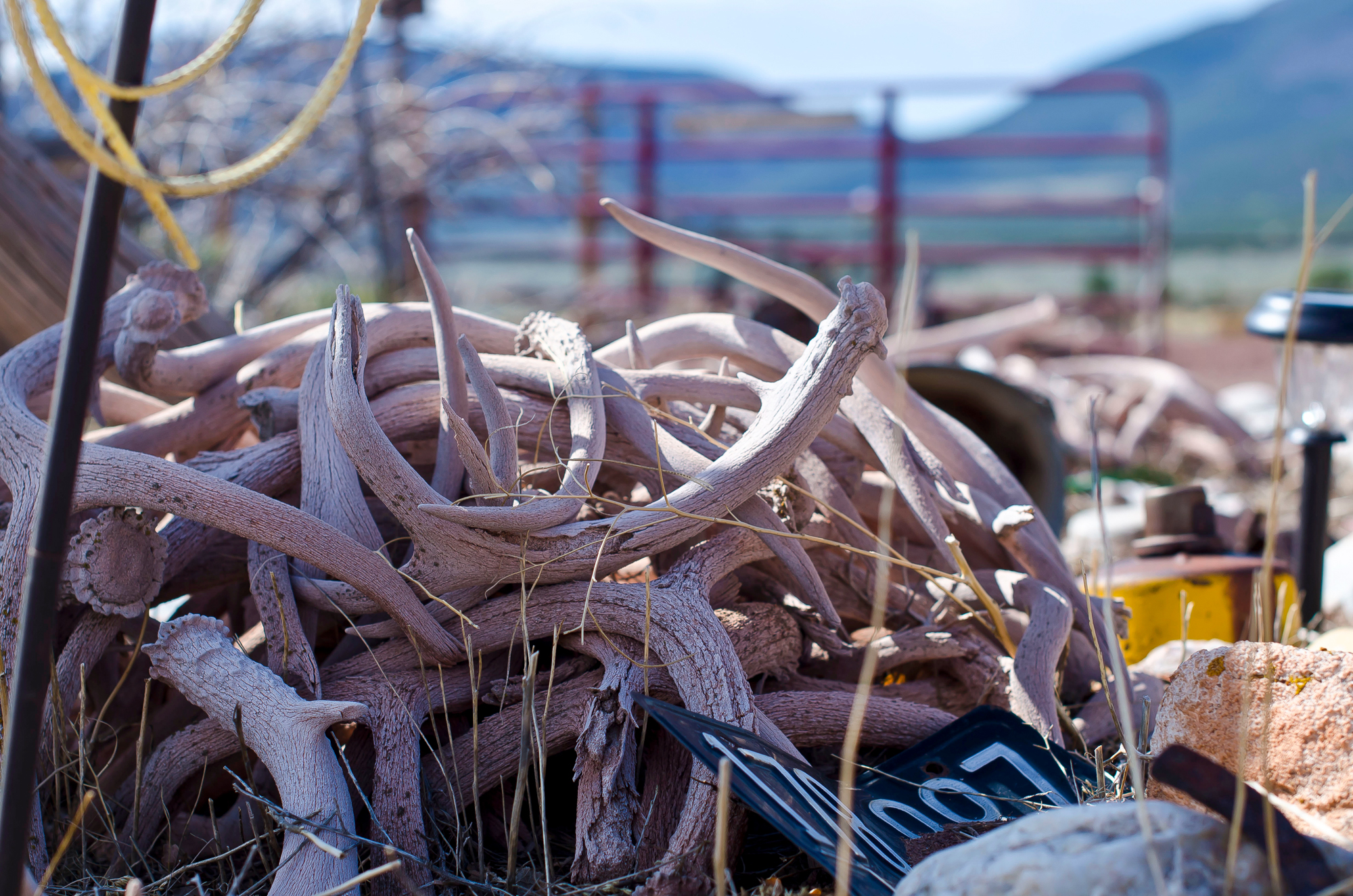
Three days later, one of Bobby’s friends from high school sent him a screenshot via Facebook. It showed some cut-off antlers from a shed hunting group that looked very similar to the photos Franny had posted. A local antler buyer had made the post, so Bobby contacted him asking if they could come by. The buyer agreed and told him if they could prove the antlers were theirs, he’d be willing to work something out.
“So, he took us back to where he had all his antlers, and as soon as we walked around the corner I started bawling because I recognized the one set right off the bat,” Franny says. “He didn’t cut that set off the skull—same with the mule deer. I showed the guy the pictures and matched them up.”
The antler buyer didn’t argue with the couple, but he had already spent $600 for the three sets. The Esplins wanted to get their clients’ mounts back as soon as possible, and they knew that if they contacted the police, the antlers would have to be processed as evidence and would likely still be there today. So, they paid the buyer $600. In addition to their client’s three racks, they got the name and number of the seller who’d brought them in.
The seller had used an alias, but the Esplins were able to determine his real name by matching it with the phone number. On Sept. 1, they contacted local law enforcement, who put two warrants out for the man’s arrest. The suspect was pulled over for a DUI three weeks later.
“I haven’t heard anything else, and I’m assuming he’s still in jail,” Franny says. “He first told the cops he had bought the antlers from somebody else, but his story just wasn’t adding up. Then the antler buyer sent the cops screenshots of their text conversation with pictures of the skulls. It turns out he had contacted the buyer within an hour of when they went missing from our shop.”
Preventing Antler Theft and Tracking Stolen Horns
McIlveen has been in that situation before. He’s dealt with law enforcement several times and says that at least once a year (that he knows of), someone will try to pawn off stolen antlers on him.
“It happens all the time. It didn’t use to be a big thing before everyone knew they were worth so much money, but even the super old ones are selling for $2 to $3 a pound,” he says. “I probably get one or two messages a month from people sending me pictures of heads or sheds that were stolen. There’s maybe 20 of us guys in the Western U.S. who buy pretty big, and we all stay in touch when something like that happens.”
McIlveen says that networking with other buyers helps reduce the number of stolen racks that end up as dog chews, dietary supplements, or collectors’ items. But there are still plenty of shady characters who fly under the radar.
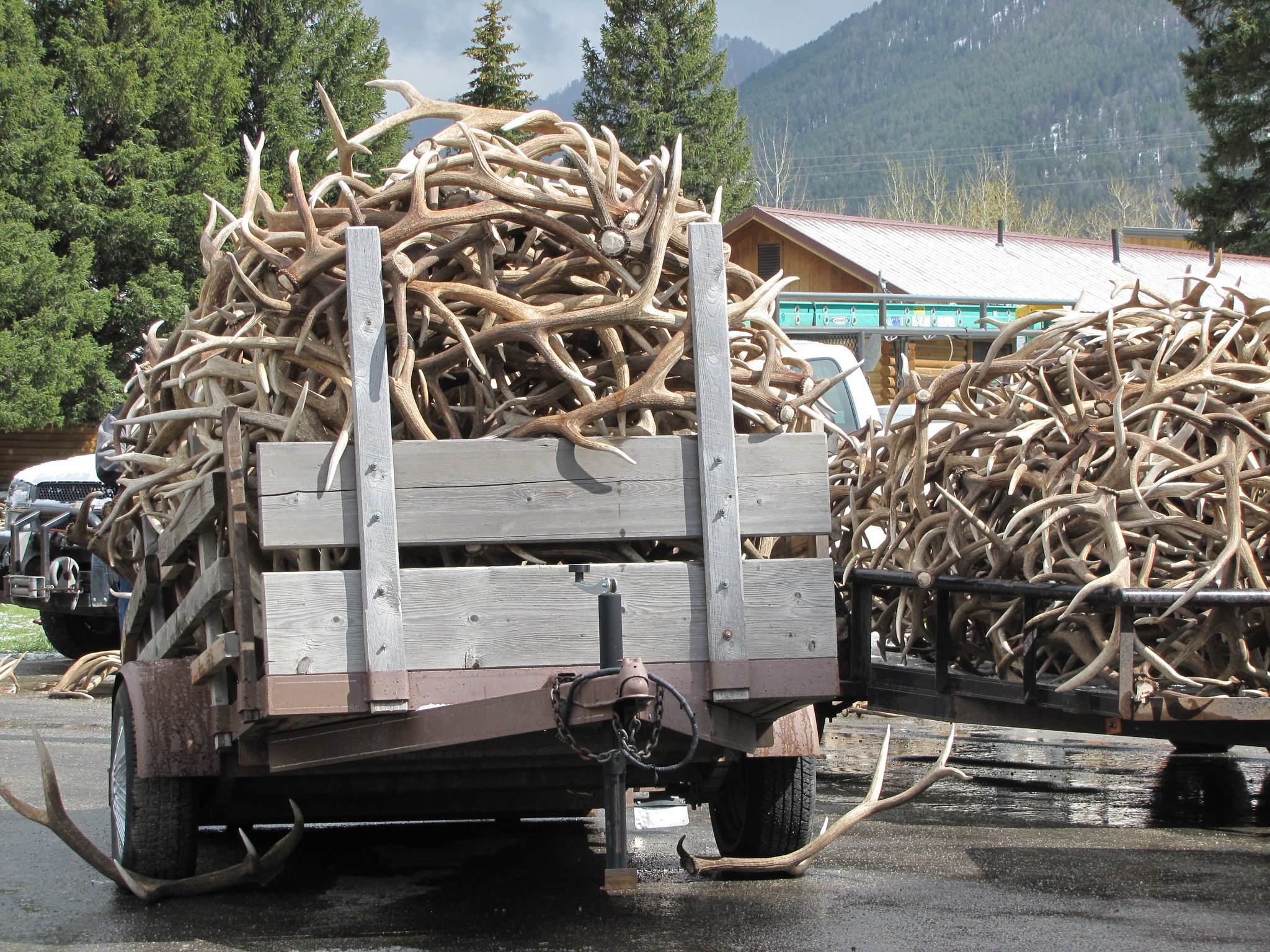
“I always try to put myself in someone else’s shoes, and that would just kill me. People work so hard for [an animal] like that, and I really hope they find them,” says Sanders, referring to the two antler thieves who are still at large in Wyoming. “I’ve heard of other guys getting horns stolen, and it sucks to see this, but hopefully it will be eye-opening. People are at least going to be more aware of it now.”
When it comes to preventing antler thefts, hunters should be extra vigilant when transporting their trophies, especially around cities and populated areas. If you’re unable to bring the skull or horns indoors for some reason, consider locking them with chains and cable locks. Even when you do make it home, keep a close eye on your antlers and treat them like a pile of gold sitting beneath a neon sign.
But as long as they fetch a price that’s worth the risk, thieves will continue to steal antlers and sell them to undiscerning (or unscrupulous) buyers. McIlveen and Sanders both say this is harder to get away with in certain Western states, which have stricter laws around the transportation and sale of antlers.
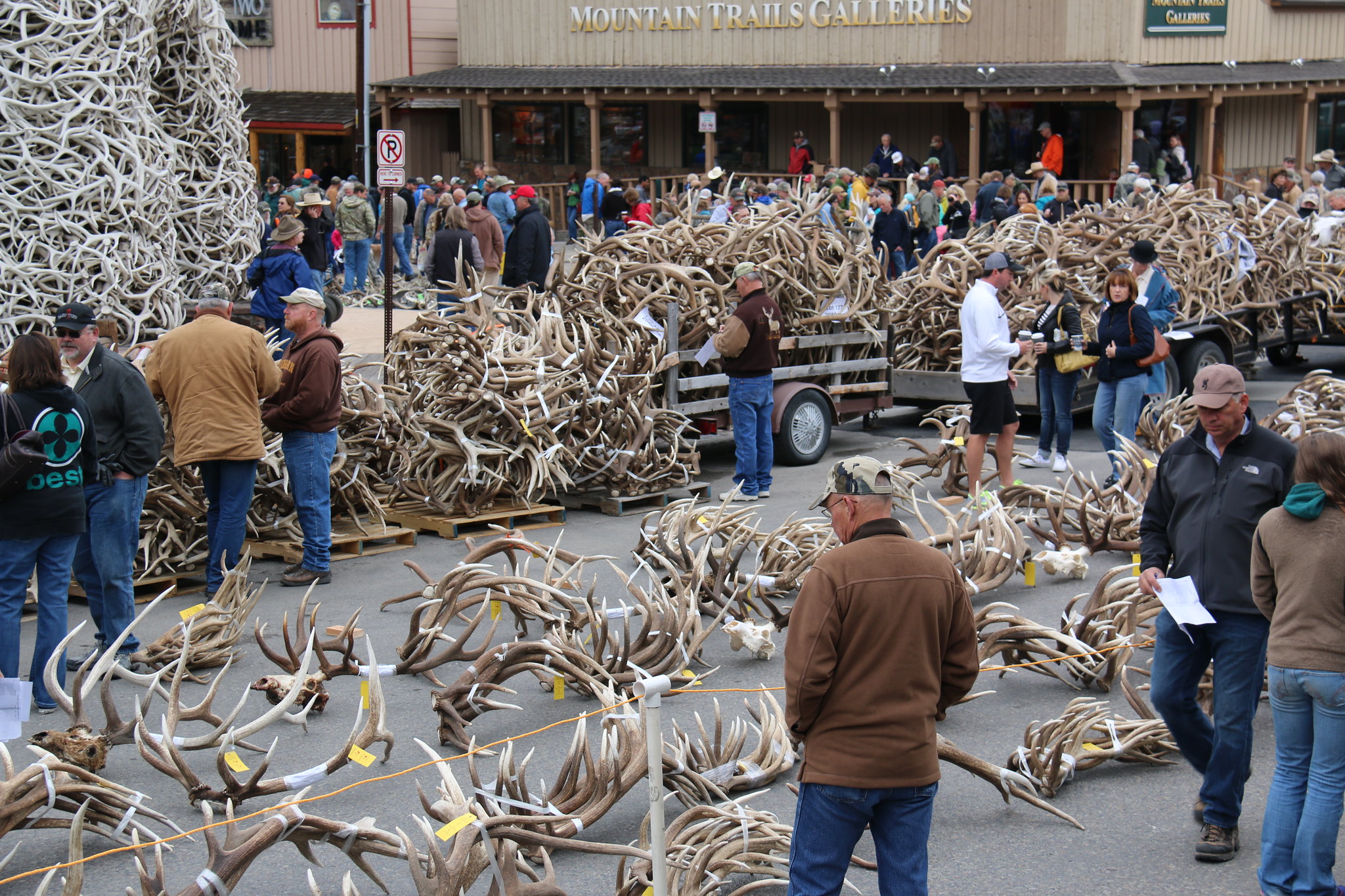
In New Mexico, for example, all big-game heads and antlers must have a state-issued receipt attached, and if a head is bartered or sold, the seller must supply the buyer with a special certificate that includes the address and hunting license number used to take the animal. Neither Wyoming nor Montana goes this far in regulating the transportation and sale of heads and antlers, and Colorado has a similar lack of regulations around harvested animal bones.
Still on the Hunt
Lynn’s buck is still missing, and the police report he filed when he got back to town hasn’t generated any leads. The only real tip he’s gotten was a response to his Facebook post about the theft. He says someone sent him a message and gave him the name of a local Wyoming hunter who, coincidentally, Lynn had seen on the mountain the same day he killed the buck. Lynn eventually got ahold of the hunter, who shared his GPS timestamps from that day and proved that he wasn’t in the area when the buck was stolen.
Knowing what he knows now, Lynn thinks another hunter must’ve stolen his trophy buck. His best guess is that he was pegged as an out-of-stater, and that a local who had the same target buck in mind took the head out of spite.
“Literally that’s the last thing you ever worry about when you’re eight miles from the trailhead,” Lynn says, adding that he took extra precaution to hang the buck’s head out of sight and well away from the trail. He jokes that in the future, he’ll sleep with the head in his tent, “ticks and all,” but realistically, he knows that’s asking for trouble in bear country.
“I mean what do you do?” he says. “I think the worst thing is that it was a sportsman doing this to another sportsman. It all comes down to a rookie mistake, I guess, because in this day and age, you can’t trust a fucking soul.”
This story first ran on November 17, 2022.

